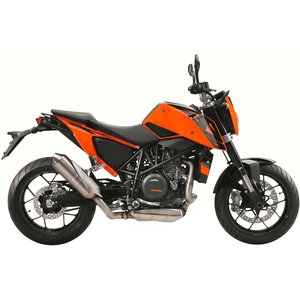KTM 690 Duke (2016–2019): The Apex Predator of Single-Cylinder Streetfighters
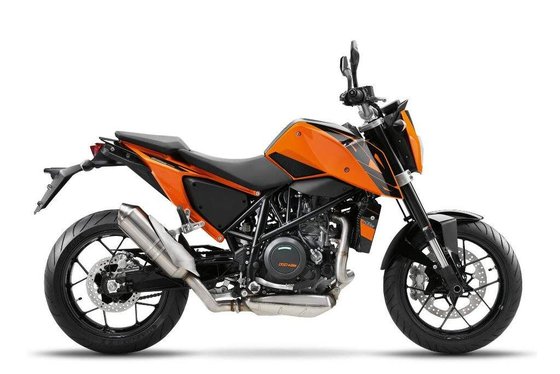
Introduction
The KTM 690 Duke isn’t just a motorcycle—it’s a statement. From its neon-orange alloy wheels to its snarling LC4 engine, this Austrian naked bike defies expectations of what a single-cylinder machine can achieve. Designed for riders who crave agility without compromise, the 2016–2019 generation refined an already-iconic formula with cutting-edge electronics, chassis tweaks, and a vibration-tamed motor. After spending a week threading it through mountain passes and urban jungles, one thing became clear: this Duke doesn’t just compete in the middleweight category—it rewrites the rules.
Riding Experience: Where Raw Meets Refined
The Heartbeat of a Giant
Firing up the 690 Duke’s 690cc LC4 engine feels like waking a sleeping dragon. The single-cylinder thump pulses through the chromoly trellis frame, but once rolling, the dual counterbalance shafts work magic. By 4,000 RPM, vibrations fade into a smooth, turbine-like whir. With 74 Nm (54.6 lb-ft) of torque peaking at 6,500 RPM and 73 HP (54.4 kW) at 8,000 RPM, the Duke accelerates with a ferocity that shatters single-cylinder stereotypes.
Twist the ride-by-wire throttle in Sport mode, and the Duke lunges forward with a linear surge. The revised bore (105mm) and stroke (80mm) let it rev 1,000 RPM higher than earlier models, pulling hard to its 9,000 RPM redline. Yet, it’s tractable enough to lug at 3,000 RPM in sixth gear—a Jekyll-and-Hyde flexibility perfect for city commutes and canyon carving alike.
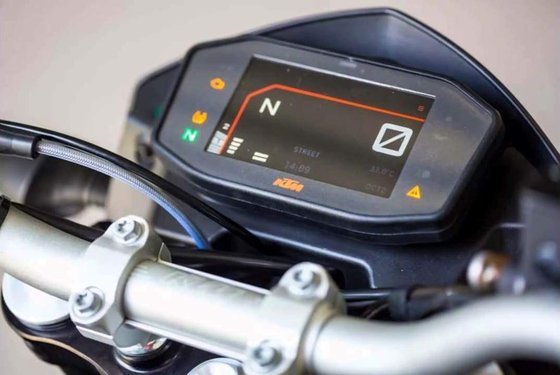
Chassis: A Scalpel in a World of Butter Knives
KTM’s obsession with mass centralization pays dividends here. At 148.5 kg (327 lbs) dry, the Duke feels like a mountain bike with a jet engine. The WP 43mm inverted fork and Pro-Lever linkage rear shock offer 135mm (5.3") of travel at both ends, tuned for aggressive street riding. Steering geometry changes—a 28mm offset (down from 32mm) and 122mm of trail—sharpen turn-in without sacrificing stability.
On tight switchbacks, the Duke flicks side-to-side with telepathic precision. The Metzeler Sportec M7 RR tires (120/70-17 front, 160/60-17 rear) grip like gecko feet, while the Brembo four-piston radial caliper biting a 320mm disc delivers stoppies on demand. Even at 150 km/h (93 mph), the chassis remains unflappable—a testament to its 9kg chromoly steel trellis frame and rigid aluminum swingarm.
Comfort? Surprise, It’s Here
The 835mm (32.9") seat height suits taller riders, but the narrow profile lets shorter inseams plant a foot. Over a 300km (186-mile) day, the sculpted seat foam proved fatigue-free, and the upright ergonomics (790mm wide handlebar, mid-set pegs) avoid wrist or back strain. Wind protection? Nonexistent—but that’s the point.
Design & Ergonomics: Form Follows Fury
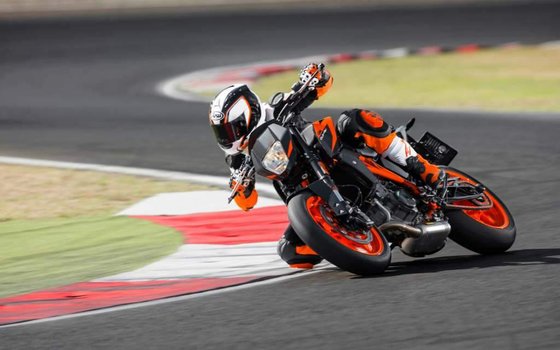
KTM’s “Ready to Race” ethos screams from every angle. The LED headlight’s predatory glare, the exposed trellis frame, and those signature orange wheels scream aggression. Yet, details like the TFT dashboard (with RPM-reactive color shifts) and LED turn signals add modern polish.
The minimalist bodywork hides a 14L (3.7-gallon) tank, offering 250-300km (155-186mi) range. Practical touches include a USB port under the seat and a tool-free adjustable clutch lever.
Technology & Electronics: Smarter Than Your Average Thumper
The Duke’s tech suite rivals liter-class bikes:
- Bosch 9.1MP ABS: Disableable rear for hooliganism.
- Ride Modes: Sport (direct throttle), Street (softened response), Rain (55 HP cap).
- Traction Control: Invisible yet effective, even on wet cobblestones.
- TFT Dashboard: Gear indicator, fuel economy stats, and a night mode that dims to reduce glare.
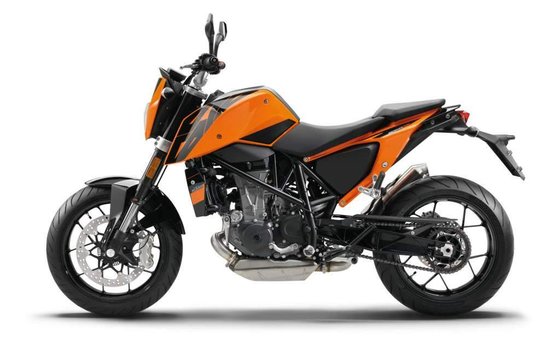
Competition: How the Duke Stacks Up
Husqvarna Vitpilen 701
- Shared DNA: Same LC4 engine, but retuned for 75 HP.
- Differences: Retro styling, lower bars, and a firmer ride. Less practical, more café-racer chic.
- Verdict: The Vitpilen seduces with looks; the Duke dominates with versatility.
Yamaha MT-07
- Twin-Cylinder Appeal: 689cc parallel twin offers smoother power delivery.
- Trade-offs: Heavier (184kg vs. 148.5kg), softer suspension, basic ABS.
- Verdict: MT-07 is a better commuter; the Duke is the weekend warrior’s pick.
Ducati Monster 797
- Air-Cooled Charm: 803cc L-twin with classic Ducati sound.
- Drawbacks: Heavier (175kg), less tech, higher seat (805mm).
- Verdict: The Monster oozes Italian flair but can’t match the Duke’s frenetic energy.
Conclusion: The 690 Duke carves a niche as the lightest, most tech-savvy single in its class. It’s for riders who value flickability over outright power.
Maintenance: Keeping the Beast Alive
Key Service Intervals
- Oil Changes: Every 10,000km (6,200mi) with 1.7L of 10W-60 synthetic.
- Valve Checks: Every 15,000km (9,300mi). Shim-under-bucket design needs precision—ideal for MOTOPARTS.store’s shim kits.
- Chain Care: O-ring chain requires lubrication every 500km (310mi). Swap to a DID 520VX3 for longevity.
Common Upgrades
- Exhaust: The stock muffler is quiet. An Akrapovič slip-on saves 3kg and unleashes the LC4’s bark.
- Suspension: WP PRO components for track-day addicts.
- Rearsets: Adjustable sets improve cornering clearance.
Pro Tips
- Vibrations: Despite balance shafts, bar-end weights or Grip Puppies reduce numbness on long rides.
- Brake Pads: Swap to Brembo SC sintered pads for better bite during aggressive riding.
- Tires: The Duke thrives on Michelin Power 5s for mixed conditions.
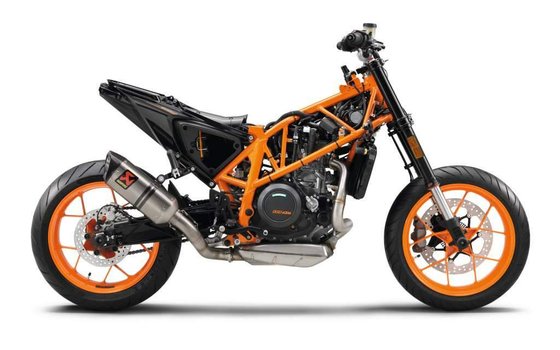
Conclusion: The Single That Thinks It’s a Superbike
The 2016–2019 KTM 690 Duke is a masterclass in contradiction: civilized yet savage, minimalist yet high-tech. It’s a bike that scoffs at freeway drones and comes alive where roads twist like spaghetti. For riders bored by predictable twins and triples, this Duke isn’t just an option—it’s an awakening.
And when it’s time to personalize or maintain your beast, remember: MOTOPARTS.store has the upgrades and OEM-quality components to keep your Duke ruling the streets.

Specifications sheet
| Engine | |
|---|---|
| Stroke: | Four-stroke |
| Max power: | 54 kW | 72.0 hp |
| Max torque: | 74 Nm |
| Fuel system: | Keihin EFI with 50 mm throttle body |
| Lubrication: | Semi-dry-sump with 2 rotor pumps |
| Max power @: | 8000 rpm |
| Displacement: | 690 ccm |
| Max torque @: | 6500 rpm |
| Bore x stroke: | 105 x 80 mm (4.1 x 3.1 in) |
| Configuration: | Single |
| Cooling system: | Liquid |
| Compression ratio: | 12.7:1 |
| Number of cylinders: | 1 |
| Dimensions | |
|---|---|
| Rear tire: | 160/60-17 |
| Wheelbase: | 1466 mm (57.7 in) |
| Dry weight: | 149 |
| Front tire: | 120/70-17 |
| Seat height: | 835 mm (32.9 in) |
| Ground clearance: | 192 mm (7.6 in) |
| Fuel tank capacity: | 14 L (3.7 US gal) |
| Drivetrain | |
|---|---|
| Final drive: | chain |
| Gear ratios: | 1st 14:35 / 2nd 16:28 / 3rd 21:28 / 4th 21:23 / 5th 23:22 / 6th 23:20 |
| Transmission: | 6-speed, APTC slipper clutch |
| Primary drive: | 36:79 |
| Rear sprocket: | 40 |
| Front sprocket: | 16 |
| Electronics | |
|---|---|
| ABS: | Bosch 9M two-channel |
| Lighting: | LED indicators |
| Ride modes: | Sport/Street/Rain |
| Instrumentation: | TFT dash with night display |
| Maintenance | |
|---|---|
| Chain type: | 5/8 x 1/4" X-Ring |
| Engine oil: | 10W-60 (alternative 10W-50) |
| Idle speed: | 1600 ± 100 rpm |
| Brake fluid: | DOT 5.1 |
| Spark plugs: | NGK LMAR7DI-10 (outer), NGK LKAR9BI-10 (inner) |
| Spark plug gap: | 1.0 |
| Coolant capacity: | 1.2 |
| Forks oil capacity: | 0.96 |
| Engine oil capacity: | 1.7 |
| Engine oil change interval: | Every 5000 km or 2 years |
| Valve clearance (intake, cold): | 0.10–0.15 mm |
| Valve clearance check interval: | 24,000 km / 15,000 mi |
| Valve clearance (exhaust, cold): | 0.20–0.25 mm |
| Recommended tire pressure (rear): | 2.2 bar (32 psi) |
| Recommended tire pressure (front): | 2.0 bar (29 psi) |
| Chassis and Suspension | |
|---|---|
| Rake: | 26.5° |
| Frame: | Chromium-Molybdenum steel trellis frame |
| Trail: | 122 mm (4.8 in) |
| Rear brakes: | 240 mm disc, Brembo 1-piston caliper, ABS |
| Front brakes: | 320 mm disc, Brembo 4-piston radial caliper, ABS |
| Rear suspension: | WP monoshock with Pro-Lever linkage, 135 mm (5.3 in) travel |
| Front suspension: | WP USD 43 mm inverted fork, 135 mm (5.3 in) travel |



